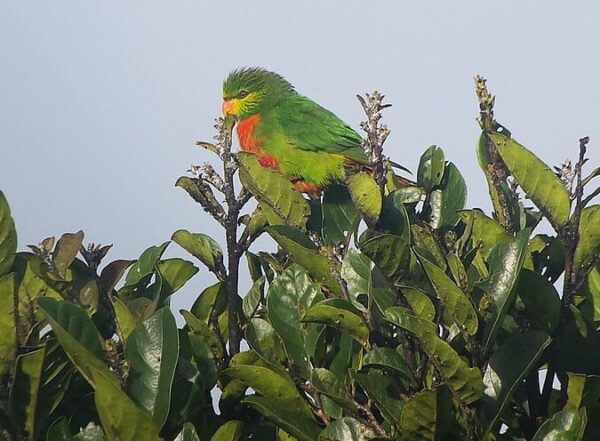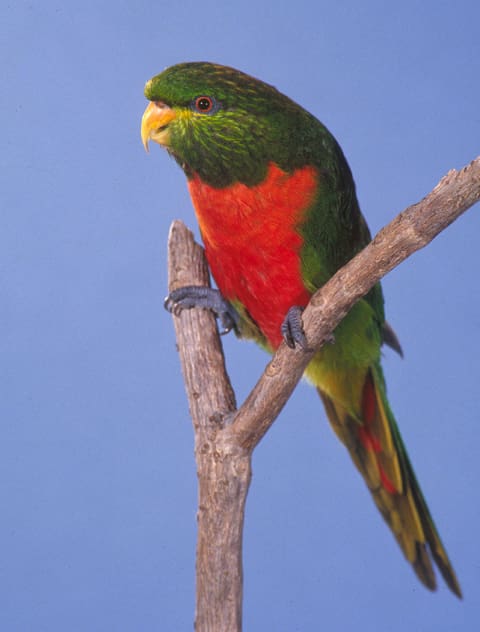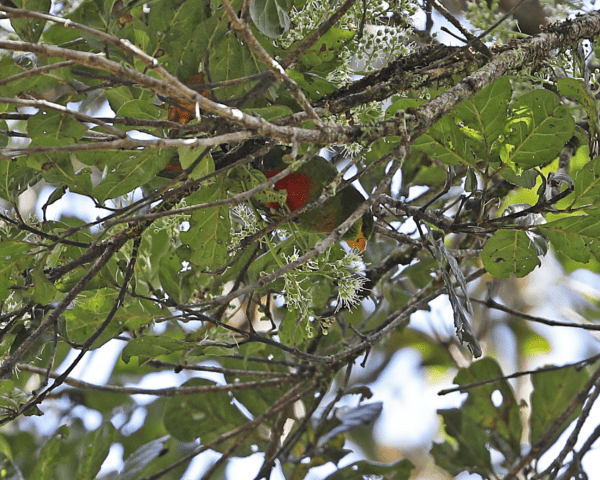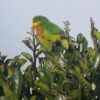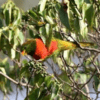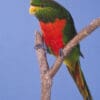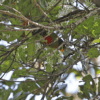Emerald Lorikeet
Also known as:
Orange-billed Lorikeet, Orange-billed Mountain Lory, Alpine Lorikeet
Also known as:
Orange-billed Lorikeet, Orange-billed Mountain Lory, Alpine Lorikeet

Neopsittacus

pullicauda
Size:
18 cm (7 in)
Weight:
28-40 g (1-1.4 oz)
Subspecies including nominate:
three: N.p. pullicauda, N.p. alpinus, N.p. socialis
Colour Adult:
N.p. pullicauda: Both adults-crown and nape softly streaked with yellow/green; nape lightly washed olive/brown; cheeks green streaked with green/yellow; red throat to centre of abdomen; red underwing coverts and underwing band; upper tail green, underneath olive/green, with red at lateral feather bases. Beak deep orange. Eye red.
N.p. alpinus: Both adults-pale orange/red breast in contrast to dark red abdomen; upper parts darker green.
N.p. socialis: Both adults-upperparts and sides of head darker green; less olive/brown on nape.
Colour Juvenile:
As in adults but generally duller in colour, with reduced red on underparts; less visible streaking on head. Beak orange/brown.
Call:
High in pitch, quiet and musical. Somewhat similar to Musschenbroek’s Lorikeet.
More Information:
Content Sources:
CITES
Lory Link
BirdLife International
Cornell Lab of Ornithology/Birds of World
Parrots: A Guide to Parrots of the World, Juniper and Parr, 1998
Parrots of the World, Forshaw, 2006. 2010 edition
Lexicon of Parrots, Thomas Arndt.
Captive Status:
Not commonly found.
Longevity:
—
Housing:
Suspended aviary 5 m (16.4 ft) long x 1.2 m (4 ft) wide x 1 m (3.3 ft) high. Plants in walk-in aviary if possible. Concrete or tiled floor.
Diet:
Fruits such as apples and pears, but any fruit may be offered; commercial or homemade nectar; seeds from fruit (where safe); brewer’s yeast, oat flakes, multi-grain mix.
Enrichment:
Loves bathing, ladders, swings, puzzle toys, noise making toys, many differing sized perches and hanging ropes. Provide flowering branches if possible (if fruit bearing make sure they are unsprayed).
Nest Box Size:
Vertical hollow log nestbox or vertical 12″ x 12″ x 24″ box (30.5 cm x 30.5 cm x 61cm).
Clutch Size:
2
Fledging Age:
—
Hatch Weight:
—
Peak Weight:
—
Weaning Weight:
—
World Population:
Unknown but reported to be common, decreasing.
IUCN Red List Status:
Least Concern
CITES Listing:
Appendix II
Threat Summary:
Not globally threatened. Generally common; little affected by habitat loss or trade. Is considered to have a high dependency on forest habitat and tree cover is estimated to have declined by 1.6% within its range over the past three generations. It is tentatively suspected that this loss may have led to an estimated <5% reduction in population.
Range:
N.p. pullicauda: Mountains of SE New Guinea, west to Sepik River region, northern Papua New Guinea.
N.p. alpinus: Snow Mountains, West Papua, east to upper Fly River region, W Papua New Guinea.
N.p. socialis: Herzog Mountains and mountains of Huon Peninsula, N Papua New Guinea.
Habitat:
Found between 1700-3800 m (5576-12,464 ft); prefers moss forest and nearby partly cleared habitat; common in primary and secondary forests, mainly at margins and tall secondary growth.
Wild Diet:
Diet includes pollen, nectar, flowers, fruits and seed cones of gymnosperm Papuacedrus papuanus, and fleshy berries of Sericolea pullei.
Ecology and Behaviour:
Is common and often seen in pairs, small groups or parties of up to 30 individuals. Travel in noisy groups. Feeds in canopy but also midway down and lower levels. Approachable and very active.
Clutch and Egg Size:
2 eggs
Breeding Season:
October. Nest is in hollow in tall tree.
Related Links:
—
